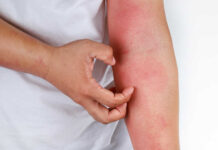
Each season presents a unique set of challenges to our skin health. Autumn leaves may bring with them a sense of dryness, winter winds chills and cracks, and spring pollen bouts of sneezing and itchy eyes.
But the hot, sunny days of summer bring their own set of problems—dehydration, sunburn, and unfortunately, unpredictable skin rashes.
Summer Skin Rashes
Why do these rashes occur predominantly in summer?
Heat rash or prickly heat, medically termed miliaria, is one of the most common types of summer skin rashes. It occurs when sweat ducts become blocked, trapping sweat under the skin. The rash usually appears as small, itchy bumps, often in skin folds or where clothing causes friction.
Other than heat rashes, there are several other triggers responsible for summer rashes. These hidden triggers are often overlooked and therefore, learning to identify them can be the first step towards effective prevention and management.
Sun Exposure
While the warm rays of the sun can be comforting, excessive sun exposure can lead to a condition called polymorphic light eruption (PMLE).
This rash usually appears as a dense cluster of small red bumps or hives, and is often mistaken for an allergic reaction. PMLE is actually an abnormal reaction to the UVA or UVB radiation from the sun, and it usually affects fair-skinned individuals who are not yet acclimated to intense sun exposure.
Plants and Pollen
Summertime brings blooming flora, which unfortunately also means more pollen in the air. For some individuals, direct contact with certain plants or exposure to airborne pollen can trigger allergic reactions resulting in skin rashes.
This condition, commonly known as contact dermatitis, presents as red, itchy, and often blistering skin lesions.
Insect Bites
Insects are more active during the summer, increasing the risk of bites and stings. For some, an insect bite is just a mild annoyance, but others may experience severe allergic reactions causing extensive rashes, swelling, and even systemic symptoms.
Chemicals in Pool Water
Chlorine, used to keep swimming pools clean, can also cause skin rashes. This is referred to as “swimmer’s itch”, pool rash, or cercarial dermatitis and presents as itchy red skin or small bumps.
Cosmetic and Personal Care Products
The use of new skin care products or cosmetics in the summer may also result in skin rashes. Some ingredients may react negatively with your skin, especially when exposed to sunlight, a reaction known as photo-contact dermatitis.
Navigating the Challenges: Prevention and Management
Understanding these triggers is the first step towards managing and preventing summer skin rashes. The key is to balance sun exposure, ensure good skincare, be mindful of plants and insects during outdoor activities, and take necessary precautions when swimming.
It’s also always a good idea to test new skincare products on a small area before full application.
However, despite all precautions, if a skin rash develops, seeking timely medical advice is crucial to prevent complications. With the right care and awareness, it’s possible to embrace the joys of summer without the discomfort of skin rashes, making the season truly one of enjoyment and relaxation.






















